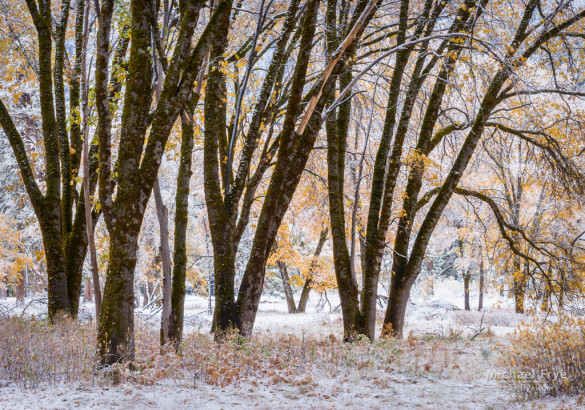
California black oaks after a snowstorm, Yosemite Valley. With forest scenes, it’s important to find as much spacing and separation between tree trunks as possible.
If light is the most important element in photography, composition is just a whisker behind. They’re both essential, and can’t be completely separated: a good composition has to take lighting into account, and you can’t think about light without considering how the light complements the subject. I already highlighted my post from last January about creating depth, but I also wrote three more posts this year about composition.
I’ve seen many otherwise excellent photographs ruined by a visual merger between important elements of the composition. When Separation is a Good Thing explains how to become conscious of these mergers and avoid this problem.
In Courting Luck, Part 2: Adapting Your Composition to the Conditions, I talk about what why I think it’s more productive to keep your compositions fluid and flexible when the light is changing quickly. And What’s the Least Interesting Part of This Photograph? is an exercise to help you tighten and strengthen your compositions.
— Michael Frye
Did you like this article? Click here to subscribe to this blog and get every new post delivered right to your inbox!
Michael Frye is a professional photographer specializing in landscapes and nature. He is the author or principal photographer of The Photographer’s Guide to Yosemite, Yosemite Meditations, Yosemite Meditations for Women, and Digital Landscape Photography: In the Footsteps of Ansel Adams and the Great Masters. He has also written three eBooks: Light & Land: Landscapes in the Digital Darkroom, Exposure for Outdoor Photography, and Landscapes in Lightroom 5: The Essential Step-by-Step Guide. Michael written numerous magazine articles on the art and technique of photography, and his images have been published in over thirty countries around the world. Michael has lived either in or near Yosemite National Park since 1983, currently residing just outside the park in Mariposa, California.









Great guidelines. But for me, its sort of difficult to describe in advance. When it comes to composition, its almost like “I’ll know it when I see it.”
Thanks Jon. Yes, composition is usually more intuitive than analytical, but I’ve found through teaching lots of students over the years that it does help to learn concepts like separation, and simplification. It might be hard to apply these concepts at first, but over time, as you look at photographs with these concepts in mind (especially your own photographs), it sinks in and starts to come through in your images.
I agree with Jon. Once I’m out working and taking photos it’s almost like the composition starts to develop once I’ve walked around the area some and I know the best approach.
David, obviously every situation is different, which is why it’s hard to apply universal rules to every situation. But I do think that learning certain concepts helps — see my reply to Jon above.
I very much like the way you used the branches and foreground in the right-hand quarter of the frame in the composition. Very nice.
Thank you Dave!